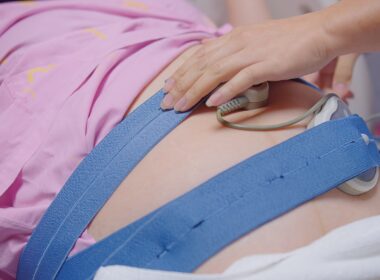The female orgasm. Books have been written about it. Conversations have been had. But this elusive creature still remains a mystery to many, women and men alike–but perhaps especially for men. So today we’re going to unpack the physical components behind the female orgasm, focusing on three things: anatomy, nerves, and hormones. After all, it’s not rocket science. Or is it? Just like so many things related to women’s health, female pleasure has a wide variation from woman to woman. It’s definitely not a one-size-fits-all, and contrary to popular opinion, there is no one magic spot that, if stimulated, causes female orgasm.
Forget the “g-spot!” Pay attention to the CUV complex instead
The clitoris is often dubbed as the (one) key to a female orgasm, i.e., stimulate the clitoris enough, and you will (eventually) orgasm–or so the thinking goes. But we now know there are several anatomical structures at play in the achievement of female orgasm.
In 2014, a group of Italian scientists published a study on the clitourethrovaginal complex [1]. They denounced the idea of a single “g-spot,” otherwise known as the Grafenberg zone after the German psychologist Ernst Grafenberg (but did we really need a published study to know this?). The Italian scientists maintained that an interconnected relationship between the clitoral, urethral, and vaginal nerves and tissues (also called the CUV complex), is responsible for nearly all female pleasure, rather than just a single spot located in the vaginal canal.
In other words, forget finding the elusive g-spot. “Getting there” is less about looking for a needle in a haystack, and more about focusing on, understanding, and stimulating the three essential physical ingredients that when mixed together just right, gives us the potent cocktail of an orgasm. Those three components are: female anatomy, the nerves that serve that anatomy, and the hormones that affect that anatomy. Let’s unpack those now.
# 1 Female anatomy
Vulva
We’ll start with the vulva, which is the area that includes your external reproductive organs (it doesn’t refer to the cervix, uterus, or ovaries, which are all internal). At the top of the vulva, you could likely point out the clitoris (considered the main female sexual pleasure center because it’s the most sensitive part of your genitals), which looks like a button or nub above the urethral opening (where pee comes out). Just below the urethral opening is the vagina or vaginal opening. The clitoris “nub” is called the glans, and it’s actually just part of the clitoris, the rest of which is largely internal. The labia majora and labia minora are skin folds on either side of the clitoris and vagina, and the top of the labia minora meet to make a little “hood” just over the glans. When you’re sexually stimulated, the clitoral glans release lubricating fluid and swell up and out of the hood, not unlike an uncircumcised penis does during an erection. But the most important areas for sexual pleasure are the internal parts of the clitoris, which are highly sensitive to pressure and swelling.
Pelvic floor muscles
Pelvic floor muscles also play a huge role in female pleasure. Pushing or pulling (just like those kegels, ladies!) on the pelvic muscles brings the cervix up and down, causing pressure (and, consequently, pleasure!) on the urethral and perineal sponges at the top and bottom of the vagina.
Individual differences in anatomy
Finally, we’d be remiss if we didn’t point out that a woman’s individual anatomy plays an important role in the female experience of orgasm, although the how and why of it is poorly understood. A 2011 study tested the theory that the distance from the clitoris to the urethral meatus determined a woman’s ability to orgasm from intercourse [2]. The findings were mixed, but the main takeaway was that variation in anatomy must play some role in women’s individual ability to orgasm from intercourse alone.
#2 The nerves that serve the female anatomy
Nerves and pelvic floor muscles help deliver all of the physical sensations during sex from the pelvic area to the brain (where they are synthesized and actually felt as pleasure). The two pudendal nerves (one for each side of the body) are mainly responsible for transmitting female sexual pleasure sensations. The pudendal nerves run from “front” (the perineum, which, as you may recall from above, is the small area between the vagina and anus) to “back” (the buttocks and lowest part of your spine), transmitting signals from all the internal and external organs and tissues along the way.
According to the Cleveland Clinic, the pudendal nerves’ 9-5 job is sending both movement and sensation data from your genitals (including the vagina, labia majora, labia minora, clitoris, urethra and anus) to your brain. The movement function of the pudendal nerve controls the muscles you use to hold or release pee and poop. The sensation function is important for perceiving sexual pleasure.
#3 The hormones that affect the female anatomy
The third and final physical component of an orgasm are your hormones. There is a massive hormonal cascade during female arousal that allows for intimacy to occur. You can thank estrogen, testosterone, and, of course, oxytocin. Estrogen and testosterone drive female libido, increase energy, and help create lubrication, but oxytocin is a hormone on its own level when it comes to importance for enjoyable sex.
Oxytocin is the feel-good, lovestruck, gooey-eyed hormone. Ironically, it’s the same hormone a new mom receives in abundance every time she nurses her baby. Or sees her baby giggle. Or takes in a love-drunk whiff of that newborn head. Who knew that the same hormones that are responsible for mother-baby bonding also drive the female orgasm? This makes sense though, when you consider that oxytocin helps women let down their guard and feel connected.
Oxytocin also works closely with dopamine and serotonin. When you combine all three of these hormones, it’s like a chemical ingredient list for the recipe for happiness. And, unsurprisingly, women are more likely to access all these hormones (and therefore experience pleasurable sex) when they feel safe, relaxed, comfortable, and confident.
Putting it all together
So, gentlemen, there’s no single button you can press to ensure female pleasure. It’s an intricate process where multiple systems have to line up. Turns out, women really are like ovens that need to preheat–not a microwave with a 1-minute cook timer (like our beloved better halves are often likened to).
Putting all of these pieces together takes a large amount of practice, exploration, and time. After all, when you throw in the whole unique male side of emotional and physical and anatomical variables, it makes sense that learning to maximize pleasure and enjoyment is going to take some time–for both people. With that in mind, it also makes sense why committed, faithful, monogamous couples, like those who are married, and especially those who practice natural family planning, report some of the highest levels of sexual satisfaction. Of course, dedicated alone time can be hard to come by when there are little kids and babies and other life responsibilities around. But sometimes you just have to make time for the kind of intimacy that makes both partners feel truly loved; take this as your sign that it will be time well spent.
Finally, there’s always libido, or sex drive, to contend with: Many women find their libido is naturally much higher around their fertile window–and there’s evidence to suggest you’re more likely to orgasm around ovulation, too. If you are trying to conceive, bravo, this will give you an extra leg up! But if you are trying to avoid pregnancy (which makes your fertile window off-limits), focusing on feeling safe, relaxed, comfortable, and confident may be able to help “hack” your brain into “getting you there,” even during the infertile times. And who knows? With a little extra preheat time you may find the cook time is just the same–or longer!
References:
[1] Jannini, E., Buisson, O. & Rubio-Casillas, A. Beyond the G-spot: clitourethrovaginal complex anatomy in female orgasm. Nat Rev Urol 11, 531–538 (2014). https://doi.org/10.1038/nrurol.2014.193 [2] Wallen, Kim and Lloyd, Elisabeth A. “Female sexual arousal: Genital anatomy and orgasm in intercourse.” Hormones and Behavior, vol. 59, no. 3 (2011): pp. 780-92. https://doi.org/10.1016/j.yhbeh.2010.12.004Additional Reading:








Great article. Another thought: chronic constipation can impair the work of pudendal nerves in children (encopresis) to the point where they don’t get signals that it is time to go. Might constipation also inhibit orgasm in women whose digestive systems typically run slow?